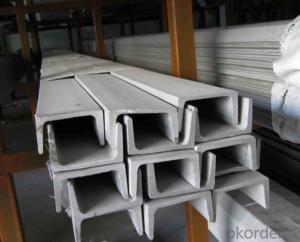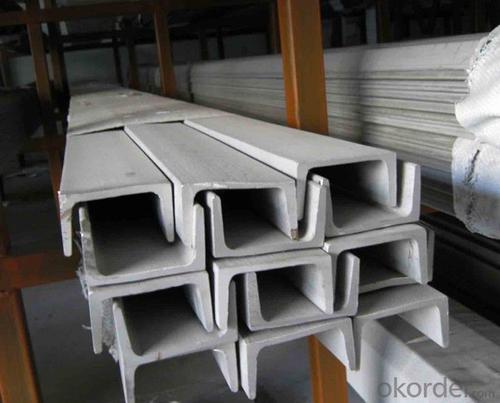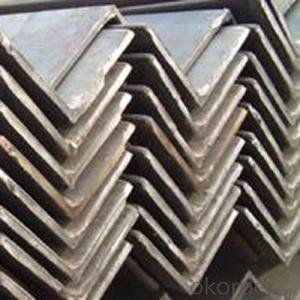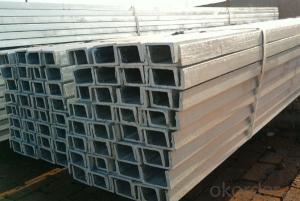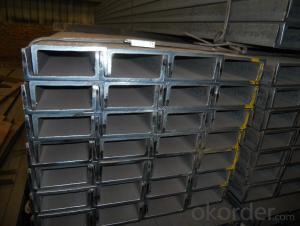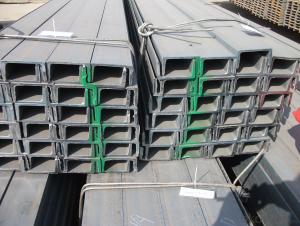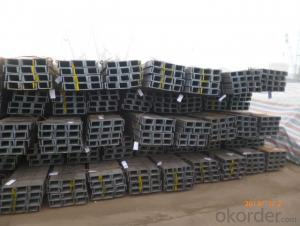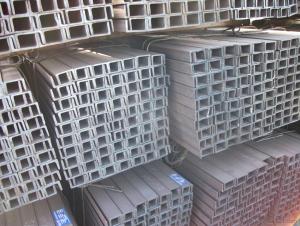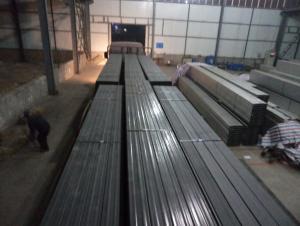Steel JIS U Channel Hot Rolled High Quality
- Loading Port:
- Tianjin
- Payment Terms:
- TT OR LC
- Min Order Qty:
- 25 m.t.
- Supply Capability:
- 20000000 m.t./month
OKorder Service Pledge
OKorder Financial Service
You Might Also Like
Specification
Product Description:
OKorder is offering Steel JIS U Channel Hot Rolled High Quality at great prices with worldwide shipping. Our supplier is a world-class manufacturer of steel, with our products utilized the world over. OKorder annually supplies products to European, North American and Asian markets. We provide quotations within 24 hours of receiving an inquiry and guarantee competitive prices.
Product Applications:
According to the needs of different structures, Angle can compose to different force support component, and also can be the connections between components. It is widely used in various building structures and engineering structures such as roof beams, bridges, transmission towers, hoisting machinery and transport machinery, ships, industrial furnaces, reaction tower, container frame and warehouse etc
Product Advantages:
OKorder's Steel Steel JIS U Channel Hot Rolled High Quality are durable, strong, and resist corrosion.
Main Product Features:
· Premium quality
· Prompt delivery & seaworthy packing (30 days after receiving deposit)
· Corrosion resistance
· Can be recycled and reused
· Mill test certification
· Professional Service
· Competitive pricing
Product Specifications:
Manufacture: Hot rolled
Grade: Q195 – 235
Certificates: ISO, SGS, BV, CIQ
Length: 6m – 12m, as per customer request
Packaging: Export packing, nude packing, bundled
Sizes: 25mm-250mm | ||||||||||||
a*t | ||||||||||||
25*2.5-4.0 | 70*6.0-9.0 | 130*9.0-15 | ||||||||||
30*2.5-6.6 | 75*6.0-9.0 | 140*10-14 | ||||||||||
36*3.0-5.0 | 80*5.0-10 | 150*10-20 | ||||||||||
38*2.3-6.0 | 90*7.0-10 | 160*10-16 | ||||||||||
40*3.0-5.0 | 100*6.0-12 | 175*12-15 | ||||||||||
45*4.0-6.0 | 110*8.0-10 | 180*12-18 | ||||||||||
50*4.0-6.0 | 120*6.0-15 | 200*14-25 | ||||||||||
60*4.0-8.0 | 125*8.0-14 | 250*25 | ||||||||||
FAQ:
Q1: What makes stainless steel stainless?
A1: Stainless steel must contain at least 10.5 % chromium. It is this element that reacts with the oxygen in the air to form a complex chrome-oxide surface layer that is invisible but strong enough to prevent further oxygen from "staining" (rusting) the surface. Higher levels of chromium and the addition of other alloying elements such as nickel and molybdenum enhance this surface layer and improve the corrosion resistance of the stainless material.
Q2: Can stainless steel rust?
A2: Stainless does not "rust" as you think of regular steel rusting with a red oxide on the surface that flakes off. If you see red rust it is probably due to some iron particles that have contaminated the surface of the stainless steel and it is these iron particles that are rusting. Look at the source of the rusting and see if you can remove it from the surface.
Q3: How do you package the angle steel when shipping?
A3: All goods are packed in bundles with steel strips and shipped by container or break bulk.
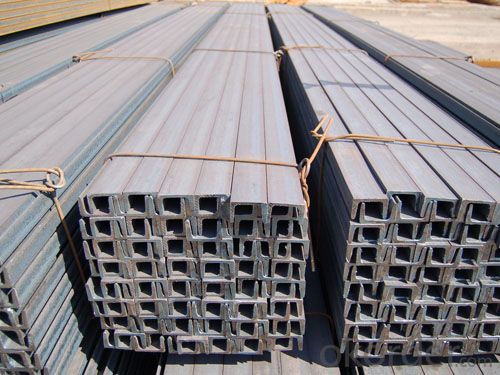
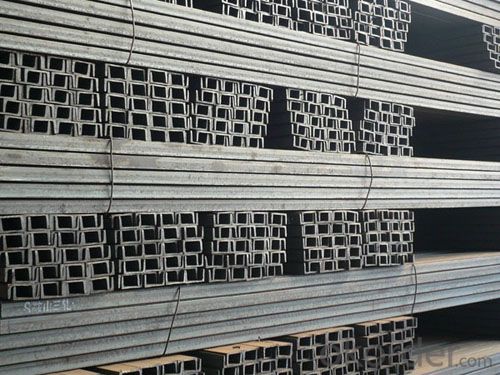
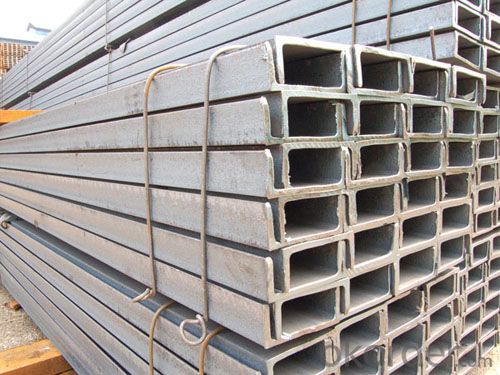
- Q: Can steel channels be used for supporting heavy machinery?
- Yes, steel channels can be used for supporting heavy machinery. Steel channels are known for their strength and durability, making them suitable for bearing heavy loads. They provide a stable and rigid support structure, ensuring the safe and secure installation of heavy machinery.
- Q: Do steel channels have any specific design considerations?
- Yes, steel channels have specific design considerations. These include determining the appropriate size and shape of the channel, considering the load-bearing capacity required, ensuring proper connections and supports, considering the potential for buckling or twisting, and accounting for any environmental conditions or corrosion concerns. Additionally, factors like material selection, fabrication techniques, and cost considerations also play a role in the design of steel channels.
- Q: What are the standard sizes for steel channels?
- The standard sizes for steel channels vary depending on the country and industry standards. In the United States, the American Standard Steel Channels (C-shapes) are available in a range of sizes, typically designated by the depth of the channel in inches and the weight per foot. Common sizes include 3x4.1, 3x5.0, 3x6.0, 4x5.4, 4x7.25, and 6x12.5. These sizes are widely used in construction, manufacturing, and structural applications. In other countries, different size standards may be followed. For example, in the United Kingdom, steel channels are often specified using the European standard designation, such as C100x50x10. This designation represents the depth (100 mm), width (50 mm), and weight per meter (10 kg/m) of the channel. It is important to note that these are just a few examples of standard sizes, and there are numerous other sizes available depending on specific requirements and applications. As such, it is recommended to consult relevant industry standards or manufacturers' catalogs for comprehensive information on steel channel sizes.
- Q: Can steel channels be used for modular construction systems?
- Certainly, modular construction systems can utilize steel channels. With their versatility, steel channels can be readily fabricated to form modular components like beams, columns, and support structures. Their exceptional strength and durability make them ideal for bearing heavy loads in modular construction. Moreover, steel channels can be effortlessly interconnected and integrated into modular systems, ensuring a flexible and efficient construction approach. Furthermore, the employment of steel channels permits convenient customization and adaptability to diverse project requirements and designs.
- Q: Can steel channels be used in automotive applications?
- Yes, steel channels can be used in automotive applications. Steel channels are commonly used in automotive manufacturing for various purposes such as structural support, reinforcement, and framework components. They provide strength, durability, and flexibility, making them suitable for automotive applications where load-bearing capacity and impact resistance are required.
- Q: What are the common safety considerations in the design of steel channels?
- Some common safety considerations in the design of steel channels include ensuring proper load-bearing capacity, structural stability, and resistance to deformation or buckling under applied loads. Additionally, factors such as corrosion resistance, fire resistance, and overall durability are also important to ensure the long-term safety and performance of steel channels. Adequate measures must be taken to prevent any potential hazards related to sharp edges, exposed fasteners, or other potential injury risks. Proper installation techniques and adherence to industry standards and codes are essential to ensure the safety of steel channel systems.
- Q: Can steel channels be used in modular data centers?
- Yes, steel channels can indeed be used in modular data centers. Steel channels are commonly used for structural support and reinforcement in various construction applications, including modular data centers. They provide high strength and durability, making them suitable for supporting heavy equipment and infrastructure in data center facilities. Steel channels can be used for framing server racks, cable trays, and other equipment mounting structures, ensuring stability and security within the modular data center. Additionally, steel channels can be easily customized and fabricated to meet specific design requirements and can be integrated seamlessly into the modular data center's overall construction.
- Q: How do steel channels contribute to building aesthetics?
- Building aesthetics can be enhanced in several ways by incorporating steel channels. Firstly, these channels serve as structural elements, providing strength and stability to the overall structure. However, they also play a significant role in improving the visual appeal of a building. One of the primary ways steel channels contribute to building aesthetics is through their sleek and contemporary appearance. With their clean lines and smooth surface, steel channels can give a building a modern and sophisticated look. They can be utilized in a range of architectural designs, from industrial to minimalist, adding a touch of elegance and refinement to the overall aesthetic. Furthermore, steel channels offer great versatility in terms of design possibilities. Architects and designers can easily customize and fabricate them into various shapes and sizes, allowing for the creation of unique and visually striking elements. Steel channels can be employed as decorative features like handrails, balustrades, or window frames, thereby adding visual interest and architectural detailing to the building. Moreover, steel channels can be finished with different coatings or treatments to further enhance their aesthetic appeal. They can be painted in various colors to complement the overall design scheme or left exposed, showcasing the natural beauty of steel. Additionally, they can be polished or brushed to achieve different textures and finishes, thereby adding depth and character to the building's appearance. Furthermore, steel channels can contribute to the aesthetics of a building by creating a sense of openness and transparency. When used as structural elements in facades, they can support large glass panels, allowing for expansive views and the entry of natural light into the building. This creates a visually pleasing and inviting atmosphere, connecting the interior spaces with the surrounding environment. In conclusion, steel channels enhance building aesthetics by providing a sleek and contemporary appearance, offering design versatility, enabling customization, and creating a sense of openness. With their clean lines, smooth surface, and various finishing options, steel channels can elevate the visual appeal of a building, adding elegance, sophistication, and architectural detailing to the overall design.
- Q: Do steel channels have any specific thermal expansion properties?
- Yes, steel channels do have specific thermal expansion properties. Like all materials, steel expands when heated and contracts when cooled. The extent of thermal expansion in steel channels depends on factors such as the composition of the steel, temperature changes, and length of the channel.
- Q: How do steel channels contribute to the overall ease of maintenance for a structure?
- Steel channels play a crucial role in simplifying the maintenance of a structure in various ways. Firstly, they offer structural support and reinforcement, ensuring the stability and longevity of the building. This means that repairs and maintenance are less frequent, as the structure can withstand external forces like wind, earthquakes, and heavy loads without significant damage or deformation. Moreover, steel channels are highly durable and resistant to corrosion, rust, and decay. Unlike materials such as wood or concrete, they do not rot, warp, or deteriorate over time. Consequently, regular inspections, repairs, or replacements due to structural degradation are unnecessary. Furthermore, steel channels are easy to fabricate and install, promoting efficient construction and maintenance processes. Their versatility allows engineers and architects to design and modify structures with ease, facilitating necessary repairs or renovations. As a result, maintenance activities cause minimal downtime and disruption. Additionally, steel channels possess a high strength-to-weight ratio, making them lightweight yet incredibly robust. This quality simplifies the transportation and handling of steel channels during maintenance projects. It also minimizes the need for extensive structural modifications, as steel channels can often be added or replaced without compromising the overall integrity of the structure. Lastly, steel channels can provide fire resistance, enhancing safety and ease of maintenance. In the event of a fire, they can help contain the spread of flames, minimize damage, and aid in the restoration process. This reduces the complexity and cost of maintenance in fire-related incidents. In conclusion, steel channels contribute significantly to the overall ease of maintenance for a structure through their structural support, durability, corrosion resistance, ease of fabrication and installation, lightweight design, and fire resistance. These attributes result in reduced maintenance requirements, increased structural integrity, and improved cost-effectiveness throughout the lifespan of a building.
Send your message to us
Steel JIS U Channel Hot Rolled High Quality
- Loading Port:
- Tianjin
- Payment Terms:
- TT OR LC
- Min Order Qty:
- 25 m.t.
- Supply Capability:
- 20000000 m.t./month
OKorder Service Pledge
OKorder Financial Service
Similar products
Hot products
Hot Searches
Related keywords
